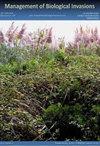Lessons learnt from large-scale eradication of Australian swamp stonecrop Crassula helmsii in a protected Natura 2000 site
IF 1.2
4区 环境科学与生态学
Q3 BIODIVERSITY CONSERVATION
引用次数: 1
Abstract
The eradication of the aquatic invasive Australian swamp stonecrop Crassula helmsii in North-western Europe usually fails. This is especially true for areas where this plant species is abundant and wide spread or the probability of re-infestation is high due to hydrological connectivity with other infested surface waters or wetlands. Therefore, the large-scale eradication of this invader is often assumed not to be cost-effective. In 2018, C. helmsii was eradicated in a wetland of 4.5 ha covering interconnected humid dune valleys on the Wadden Island of Terschelling in the Netherlands. The total costs of this large-scale project were estimated to be 1.5 million euro. The applied method was excavation of infested locations and replenishing these areas with clean (uncontaminated by C. helmsii) sand to restore boundary conditions suitable for recovery of the treated habitats in this Natura 2000 site. An eight step approach was implemented to eradicate the invasive plant species. Aftercare consisted of a monitoring program with six-weekly vegetation surveys for early detection of any regrowth of C. helmsii and assessment of the effectiveness of the eradication measures. The eradication of C. helmsii was regarded successful since this fast growing plant species was not observed in the areas of concern during a period of at least two years. The results of a strength, weaknesses, opportunities and threads (SWOT) analysis revealed that the method for eradication of this invasive plant species was effective to secure nature values but also complex, time consuming and costly. Our lessons learnt and recommendations for management will help other nature managers making the right decisions in determining appropriate eradication measures for C. helmsii.从大规模消灭澳大利亚沼泽石竹在自然2000保护区的经验教训
在欧洲西北部,水生入侵的澳大利亚沼泽石竹(Crassula helmsii)的根除通常失败。对于这种植物种类丰富和广泛分布的地区,或者由于与其他受侵染的地表水或湿地的水文连通性而再次侵染的可能性很高的地区尤其如此。因此,大规模消灭这种入侵者通常被认为不具有成本效益。2018年,在荷兰瓦登岛Terschelling的一块4.5公顷的湿地上,helmsii被消灭,这块湿地覆盖了相互连接的潮湿沙丘山谷。这个大型项目的总成本估计为150万欧元。采用的方法是挖掘受侵染的地点,并用干净的(未受黑僵菌污染的)沙子补充这些区域,以恢复适合于恢复该Natura 2000站点处理过的栖息地的边界条件。采用八步法对入侵植物进行根治。后续护理包括一个监测项目,每六周进行一次植被调查,以便及早发现任何赫尔姆梭菌的再生,并评估根除措施的有效性。由于在至少两年的时间内没有在有关地区观察到这种快速生长的植物物种,因此认为成功地消灭了海姆丝兰。SWOT分析结果表明,根除该外来入侵植物的方法是有效的,但同时也是复杂、耗时和昂贵的。我们的经验教训和管理建议将有助于其他自然管理者在确定适当的根除黑氏弧菌措施方面做出正确决策。
本文章由计算机程序翻译,如有差异,请以英文原文为准。
求助全文
约1分钟内获得全文
求助全文
来源期刊

Management of Biological Invasions
Agricultural and Biological Sciences-Ecology, Evolution, Behavior and Systematics
CiteScore
3.40
自引率
6.70%
发文量
21
审稿时长
16 weeks
期刊介绍:
Management of Biological Invasions, established in 2010 by Dr. Elias Dana, is an open access, peer-reviewed international journal focusing on applied research in biological invasions in aquatic and terrestrial ecosystems from around the world. This journal is devoted to bridging the gap between scientific research and the use of science in decision-making, regulation and management in the area of invasive species introduction and biodiversity conservation.
Managing biological invasions is a crisis science, with Management of Biological Invasions aiming to provide insights to the issues, to document new forms of detection, measurements and analysis, and to document tangible solutions to this problem.
In addition to original research on applied issues, Management of Biological Invasions publishes technical reports on new management technologies of invasive species and also the proceedings of relevant international meetings. As a platform to encourage informed discussion on matters of national and international importance, we publish viewpoint papers that highlight emerging issues, showcase initiatives, and present opinions of leading researchers.
 求助内容:
求助内容: 应助结果提醒方式:
应助结果提醒方式:


